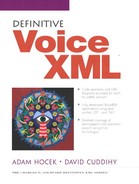VoiceXML document structure
Each VoiceXML document must have a vxml element as its root node. Figure 3-1 lists the legal children of the vxml element type.
Figure 3-1. VXML element type's legal children

All of these children are other VoiceXML element types except two: event.handler and dialog. These are abstract element types, defined as entities in the DTD. Each of them can represent a union of element types.
Figure 3-2 shows the event.handler element types. Any of these event.handler element types can legally be a child of the vxml element type.
Figure 3-2. The event.handler element types

Figure 3-3 shows the definition of the abstract dialog element type which includes form and menu. These are the two types of dialogs defined in VoiceXML. Both of these element types may be children of a vxml element.
Figure 3-3. The form and menu dialog element types

The menu element type is the parent of choice, property, or prompt element types as well as event.handler element types, previously defined in Figure 3-2, and audible element types which will be defined shortly. Similarly, the form element type is the parent of script, property, link, filled, var, and grammar element types as well as event.handler element types, previously defined, and form.item element types.
The form.item elements, shown in Figure 3-4, play a particular role in the Form Interpretation Algorithm.
Figure 3-4. The form.item element types

The element types that each form item can contain are covered in more detail in the respective element type sections below.
Another abstract element type that appears in Figure 3-3 is executable.content. Executable content elements are typically found as children of either the block, filled, if, or event.handler elements. Figure 3-5 shows the element types that can be interpreted as executable.content. The VoiceXML interpreter typically treats such elements as procedural statements.
Figure 3-5. The executable.content element types

The element types that are children of the executable.content elements are discussed in the respective following sections. It is worth pointing out that the abstract element type variableAccessor shown in Figure 3-5 is not actually in the DTD but is added here for clarity.
The audible element types represent audio that can be played back. It is worth noting that audible is implemented in the DTD as an entity named audio. Since there is also a VoiceXML element type audio, we will refer to this entity as audible in this text for the sake of disambiguation. Figure 3-6 lists the audible element types. You will notice that PCDATA (parsed character data) can be interpreted as audible content, as is the case with plain text processed by a text-to-speech processor.
Figure 3-6. The audible element types

Looking back at Figure 3-3 we see that the menu, choice, and prompt element types all have audible element types as their children.
In addition to audible element types, there is also the abstract tts element type, referring to Text-To-Speech. The element types that can be interpreted as tts are shown in Figure 3-7.
Figure 3-7. The tts element types

The tts element types are new to VoiceXML 2.0 and are used to either organize or mark up text to be processed by a text-to-speech processor. As we can see from Figure 3-3, choice and prompt element types can be parents of tts element types.
While the element types for controlling audio output, namely audible and tts, can be found as children of various VoiceXML element types, the element types for controlling audio input are found only as children of the grammar element type. Figure 3-8 shows the taxonomy of a grammar definition using the GRXML standard grammar definition format.
Figure 3-8. The grammar element type taxonomy

The details of each of these element types will be described in the sections that follow.
